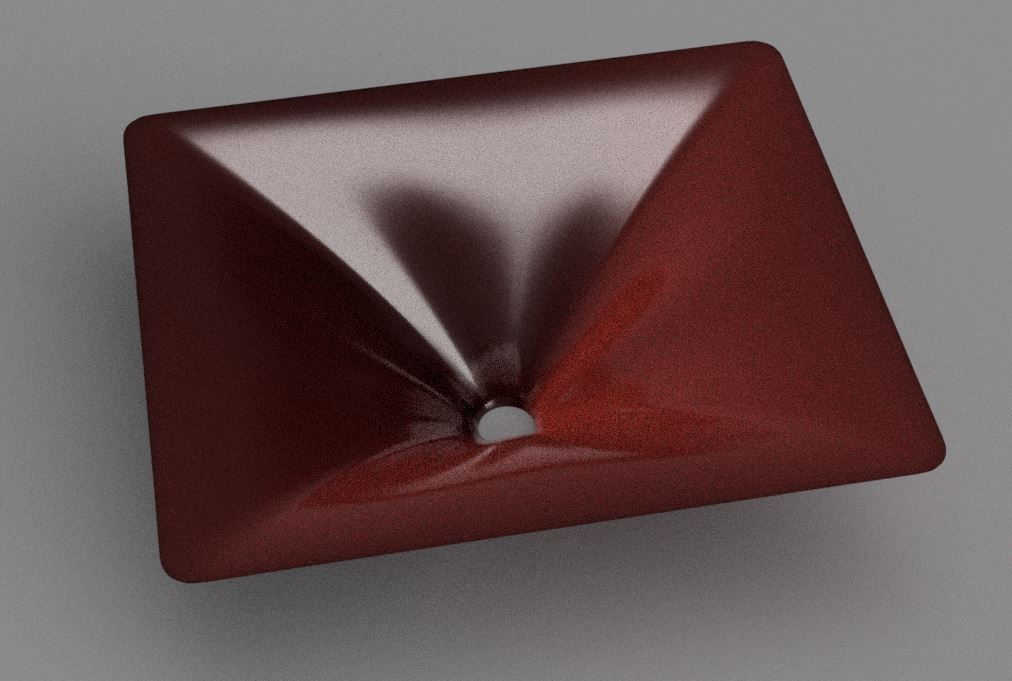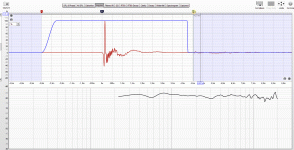You'll see it when you get it...
This is really important info for me. I have an idea what a FR and DI should like: flat and smooth. But to find out what is the problem when it isn't is much harder. These things: wiggles here -> 'reflection' in IR -> caused by diffraction at waveguide edge, is crucial info.
Didn't we try to visualize that earlier during our wiggle-hunt?
Edit: I mean this: https://www.diyaudio.com/community/...-design-the-easy-way-ath4.338806/post-7233069
This is really important info for me. I have an idea what a FR and DI should like: flat and smooth. But to find out what is the problem when it isn't is much harder. These things: wiggles here -> 'reflection' in IR -> caused by diffraction at waveguide edge, is crucial info.
Didn't we try to visualize that earlier during our wiggle-hunt?
Edit: I mean this: https://www.diyaudio.com/community/...-design-the-easy-way-ath4.338806/post-7233069
Last edited:
Great. That should be a reflection from something solid. When it's a reflection from a transition "solid boundary -> free air", it changes polarity, as in the simulated example above.
Any chance you would be able to post the 3-D model or the script that you used to generate this horn in ATH4?Right now there is this waveguide being made (422 x 364 mm; 1,4" throat for 18Sound ND3T) -

I'm really eager to see how it turns out, it's probably my best so far. Two different loudspeakers will be made with it, the second one with BMS 4554. Hopefully, we'll see the measured data soon.
It's been made available as the Tritonia Waveguide (for DIY) and still works in Ath 4.9:
Code:
; -------------------------------------------------------
; Tritonia Waveguide
; (C)2021 Marcel Batík licensed under CC BY-NC-SA 4.0
; Ath version 4.9
; -------------------------------------------------------
Throat.Diameter = 36 ; [mm]
Throat.Angle = 4.2 ; [deg]
Throat.Profile = 1
Length = 135 ; [mm]
Coverage.Angle = 48.5 - 7*cos(2*p)^5 - 16*sin(p)^12
Term.s = 0.7 + 0.2*cos(p)^2
Term.n = 3.7
Term.q = 0.995
Morph.TargetShape = 1
Morph.FixedPart = 0.0
Morph.Rate = 3
Morph.CornerRadius = 18 ; [mm]
; -------------------------------------------------------
; Mesh Setting
; -------------------------------------------------------
; ABEC
Mesh.AngularSegments = 80
Mesh.LengthSegments = 26
Mesh.CornerSegments = 4
;Fusion 360
;Mesh.AngularSegments = 60
;Mesh.LengthSegments = 16
;Mesh.CornerSegments = 5
Mesh.ThroatResolution = 5
Mesh.MouthResolution = 10
Mesh.InterfaceResolution = 7
Mesh.SubdomainSlices = 26
; -------------------------------------------------------
; ABEC Project Setting
; -------------------------------------------------------
ABEC.SimType = 1
ABEC.f1 = 400 ; [Hz]
ABEC.f2 = 12000 ; [Hz]
ABEC.NumFrequencies = 40
ABEC.MeshFrequency = 1000 ; [Hz]
ABEC.Polars:SPL_H = {
MapAngleRange = 0,90,19
Distance = 2 ; [m]
}
ABEC.Polars:SPL_V = {
MapAngleRange = 0,90,19
Distance = 2 ; [m]
Offset = 145
Inclination = 90
}
ABEC.Polars:SPL_D = {
MapAngleRange = 0,90,19
Distance = 2 ; [m]
Offset = 145
Inclination = 42
}
Output.STL = 1
Output.ABECProject = 1
Report = {
Title = Tritonia
PolarData = SPL_H
Offset = 145
NormAngle = 10
}- As the ST260 turned out to be already a bit too directional for that, I'm also working on a waveguide specifically designed to be used with a cardioid midrange (~300mm):

(Some more tricks learned along the way...)
Pretty happy so far 🙂
The DI around 7dB around 1 kHz (~120deg beamwidth) seems to be what's needed.
(Some more tricks learned along the way...)
Pretty happy so far 🙂
The DI around 7dB around 1 kHz (~120deg beamwidth) seems to be what's needed.
Last edited:
Done 🙂

Basic "cardioid mid" enclosure possible - ports on top and the sides:



Basic "cardioid mid" enclosure possible - ports on top and the sides:
All options are open, that's just an initial sketch. But I like the design, as it's generally difficult to incorporate a short free-standing waveguide so that it would look good overall. This has a nice balance of masses. The driver is actually hidden near the mouth, mounted via a silentblock, the rest is only a (e.g. concrete-filled) holder.
Last edited:
I just like it.



Perhaps with an additional front support it would look even better.
Perhaps with an additional front support it would look even better.
Are there any instructions how to create a .step file in Fusion 360 from the curves export? I've never used Fusion 360 and want to get back to Creo as quickly as possible 😵
I think you need to have a body first. The curves you can export to dxf. But be mindful that they are 90 degrees rotated for me at least. (So a drawing sticking out of the paper 😀 )
For axisymmetric devices the afp file option works best with it's associated plugin. For non axisymmetric devices the Grid export options and plugins is needed. Which one are you trying to use and how far have you got?Are there any instructions how to create a .step file in Fusion 360 from the curves export? I've never used Fusion 360 and want to get back to Creo as quickly as possible 😵
I'm confused how to use NormAngle in ATH reports. Why is 10 degrees the standard normalization? Does that mean your want to equalize frequency response flat at 10 degrees after you build the speaker? Does it mean you want to listen to the speaker at 10 degrees off-axis from your line of sight to the speaker?
When this software was first created, Earl Geddes pioneering work was considered not only with regard to the waveguide profile, obloid spheroidical, but also his theory on the minimization of first reflections through a speaker setup with considerable toe-in to maximize image quality was taken into account. Direct sound would hence arrive via a 20-something off-axis angle. Additionally, the 0-angle with an axisymmetric device would necessarily suffer if from an ever so slight cancellation. Although this cancellation can by now be reduced to a degree that makes this a subjective non issue, technically, it is still good advice to engineer the waveguide from a close off-axis angle. This is the history. There might be other applications of waveguides where this might have less relevance.
- Home
- Loudspeakers
- Multi-Way
- Acoustic Horn Design – The Easy Way (Ath4)
